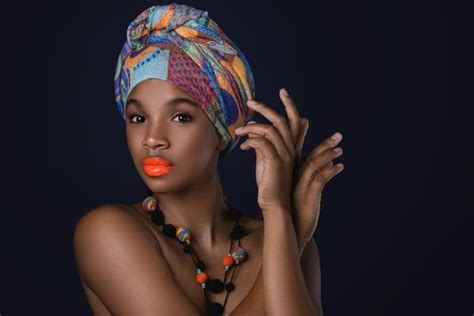African head wraps, also known as gele or tuku, have been a staple of African fashion for centuries. Worn by women of all ages and backgrounds, head wraps serve both practical and cultural purposes.

Benefits of African Head Wraps
1. Hair Protection:
Head wraps protect hair from the sun’s harmful UV rays, dust, and wind. This helps prevent hair damage, breakage, and dryness.
2. Moisture Retention:
Head wraps create a seal around the hair, helping to retain moisture and prevent it from drying out. They also promote scalp health by reducing scalp irritation and inflammation.
3. Heat Insulation:
Head wraps provide insulation from extreme temperatures, keeping the head warm in cold weather and cool in hot weather.
4. Versatility:
Head wraps can be worn in countless ways, from simple knots to elaborate turbans. This versatility allows them to complement any outfit and suit any occasion.
5. Cultural Expression:
Head wraps are an important part of African culture and heritage. Different colors, patterns, and styles of head wraps hold symbolic meanings and represent different tribes, regions, and traditions.
6. Economic Empowerment:
The head wrap industry has created employment opportunities for artisans and entrepreneurs. Many women in Africa earn a living by making and selling head wraps.
7. Health Awareness:
In recent years, head wraps have become associated with the fight against cancer. Many cancer survivors wear head wraps to cover their heads after losing their hair to chemotherapy.
Step-by-Step Guide to Tying an African Head Wrap
Materials:
- Large square or rectangular scarf
- Bobby pins or hair clips (optional)
Instructions:
- Fold the Scarf: Fold the scarf in half diagonally to create a triangle.
- Place on Head: Position the folded scarf on your head with the point at the front.
- Tie the Ends: Bring the two long ends of the scarf together at the back of your head and tie them securely.
- Adjust and Style: Adjust the scarf to your desired position and style as needed, using bobby pins or hair clips for added security.
Table 1: Types of African Head Wraps
| Type | Description |
|---|---|
| Gele | Yoruba head wrap made of elaborate fabric |
| Tuku | Hausa head wrap made of a large piece of cloth draped around the head |
| Aso Oke | Yoruba head wrap made of handwoven cloth |
| Bandana | Common head wrap made of a square piece of cotton |
| Turban | Head wrap made of a long piece of fabric wrapped around the head in a spiral |
Table 2: Benefits of Head Wraps by Age Group
| Age Group | Benefits |
|---|---|
| Infants | Protect hair from sun damage and irritation |
| Children | Keep hair neat and tidy, protect from lice |
| Adolescents | Express creativity and style, prevent split ends |
| Adults | Maintain hair health, enhance appearance |
| Seniors | Protect hair from thinning and breakage |
Table 3: Head Wraps in Different Cultures
| Culture | Head Wrap Tradition |
|---|---|
| Yoruba (Nigeria) | Gele worn by women of all ages |
| Igbo (Nigeria) | Isi Agu head wrap made of beads |
| Hausa (Nigeria) | Tuku worn by married women |
| Akan (Ghana) | Kente head wrap worn by royalty |
| Zulu (South Africa) | Isiphandla head wrap made of leather |
Table 4: Head Wraps for Special Occasions
| Occasion | Head Wrap Style |
|---|---|
| Weddings | Gele or Aso Oke head wrap |
| Funerals | Black head wrap |
| Birthdays | Colorful head wrap |
| Religious Festivals | Head wrap with symbolic motifs |
| Formal Events | Turban or elaborate head wrap |
Conclusion
Whether for practical or cultural purposes, African head wraps offer numerous benefits to women of all ages. Their versatility, aesthetic appeal, and deep-rooted significance make them a timeless fashion accessory that continues to be embraced by millions around the world.
